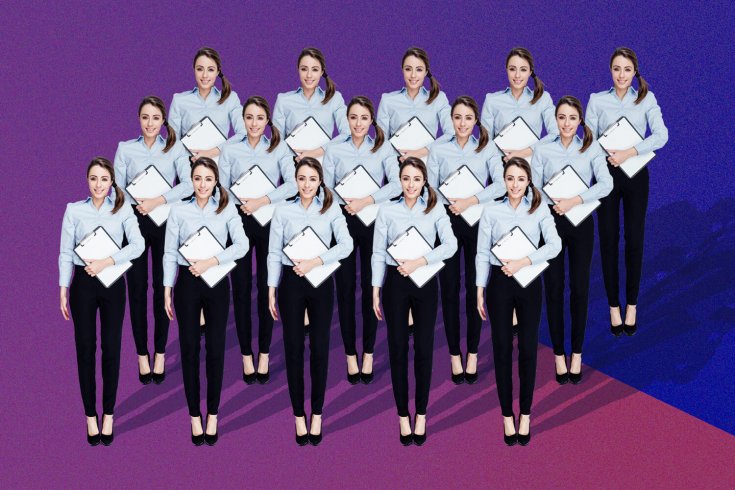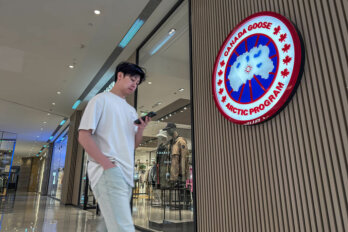When I was nineteen, I worked full time as a front-desk clerk in a business hotel in downtown Edmonton. This was during a period between high school and university when I was broke and couch surfing. I had no money, no parental safety net, and no childhood home to land in. I was on my own. The hotel job, which paid around $8 an hour, was supposed to get me into my own apartment where I could start saving for school.
This job, more than any I’d had before, made me feel like I was playing adult, partly because of the responsibility of watching over an entire hotel during evenings and partly because of what I was made to wear: a silk blouse in a dark jungle print and a black blazer, both supplied by the hotel. I contributed a pair of black dress pants likely purchased from a sale rack at Le Château.
The hotel uniform wasn’t my first, but it was the first that required a blazer, which was a symbol of authority entirely alien to my circumstances. Outside of work, my clothing leaned to the goth end of the thrift-store-chic spectrum that was big in the late ’90s. Old logo tees over jeans. A black vinyl bustier paired with a short skirt and fishnet stockings. A brown leather jacket from the ’70s and authentic vintage combat boots. It was a time when being dirt poor didn’t stop you from having style. My uniform left me feeling prematurely middle aged, but at least I looked like I knew what I was doing—or so I thought.
One day, I caught my manager and coworker laughing at me. They were hospitality lifers, and they often found my naïveté about certain aspects of the industry funny. I asked them what the problem was, and my boss pointed to my shoes—my best dress shoes, a pair I’d owned since high school. They were brown. Brown shoes with black pants was apparently a hilarious faux pas that no one had bothered to tell me about. Terrified the hotel would fire me if I didn’t get the look right (I’d seen other employees have their hours slashed for less), I borrowed money from a friend to replace the shoes before my next shift.
I’d been made to understand, from a young age, the importance of being taken seriously in professional situations. I was raised by a single mother who worked mostly as a secretary. To prepare for my future, I did typing drills and collated files when I was barely out of junior high school. Handy with a word processor and a multiline phone, I developed the kind of pleasant, capable disposition that made me hireable for jobs that normally went to older people.
What my mother didn’t prepare me for was how my clothing choices could mark me as not belonging in those professional spaces. When I tell the shoe story, people ask why I didn’t just laugh off my manager’s nitpicking. What they don’t understand is the economic vulnerability of my situation. In her essay “The Price of Fabulousness,” sociologist Tressie McMillan Cottom writes that for poor people, and particularly for black women, dressing appropriately can be a matter of survival. “We want to belong. And not just for the psychic rewards,” she argues, “but belonging to one group at the right time can mean the difference between unemployment and employment, a good job as opposed to a bad job, housing or shelter, and so on.” Those brown shoes undermined the authority of the blazer, threatened the tenuous sense of stability I’d gained in that job, so I spent money I didn’t have on a new piece of clothing in the hopes of fitting in. It wasn’t the first time and it wouldn’t be the last.
It’s no surprise many women experience a lifelong anxiety around professional dress codes—rules, in some cases, so discriminatory they’ve triggered legal action. In Ontario, it’s illegal to force male and female employees to wear different uniforms. In BC, a 2004 human rights tribunal case against a club awarded a server damages after she was pressured into quitting for refusing to wear a bikini top to work. Within the past year, Alberta has joined BC, Ontario, and Manitoba in banning mandatory high heels in workplaces, citing health-and-safety risks. These new laws make it easier for women, but they don’t address the myriad ways our bodies are monitored for how we get it wrong.
Is that a visible bra strap? Are your shirt buttons straining across your chest? Did I see a hint of flesh beneath your shirt, the line of your underwear? The scrutiny is, of course, applied far more vigorously if you are anything other than rich, thin, able bodied, white and cis. What’s more, these rules seem to change without notice. They shift from situation to situation, requiring a person anticipate the new sartorial reality, then have the resources to adapt to it. Belonging is expensive. The more vulnerable you are, the higher the price you pay.
For many of us, it’s a necessary price. We are told that if we internalize the right dress codes, we can overcome whatever systemic obstacles lie before us. Endless blogs and magazine articles attempt to teach us how to dress for success. There have also been a spate of reality TV shows dedicated to tearing down and rebuilding participants, often women, in the name of saving them from a life-destroying inability to garb themselves appropriately.
The best known of the genre was the long-running reality makeover show What Not to Wear. In her 2016 excoriation of the bland confines of professional dress for The Establishment, “‘Toddler Grandma Style,’ The Fashion Approach that Will Set You Free,” fat activist Cynara Geissler criticizes the show’s version of “professionalism.” She argues that “our culture has absorbed and perpetuated the mind-numbingly dull idea that the best way to signal that you are a smart adult woman is to don suit jackets, favor neutrals, and wear heels.”
The show reinforced its message with ridicule. Indeed, part of its appeal was watching the horror of hosts Clinton Kelly and Stacy London at the fashion choices of their guests—often pink-collar women who looked like my mother and aunts, women who looked like me. “You’re going to be overlooked for what you say if you don’t put yourself together in a way that commands attention,” London scolds one abashed medical student in an episode from 2011. In an episode from 2013, the hosts face a housewife with a taste for short, tight dresses and designer labels. “You do know it’s possible to spend a lot of money and still look cheap,” Kelly chides.
WNTW ended its run six years ago. But, in its absence, the genre survives. Perhaps the worst example is a show called 100% Hotter, in which a trio of stylists with impeccable hair gawk in horror at outlandishly dressed guests and assign humiliating tasks aimed at teaching them how to look more normal. Even the gentler reboot of Queer Eye, with five warm-hearted hosts doing whole-life makeovers, can’t avoid teasing its subjects.
The message, in many of these cases, is that the world will treat you with respect if you follow the rules. It never seems to occur to the well-meaning fashionistas that those rules are arbitrary and exist largely to exclude and oppress the very people they claim to help.
Anxiety about professional dress stayed with me into my thirties and came to head when I was offered a position teaching my first university class around five years ago. I’d learned how to dress for the hospitality industry: black dress pants and white collared shirts when I was catering, jeans and a baby tee when I was working at a pub. As a freelance arts reporter, I’d mostly flown under the radar in denim and a nice shirt, which also worked for a writing tutor and ESL teacher. Sometimes, I would splash out and try a patterned romper or a short A-line dress over leggings. My casual work uniform meant that I was frequently mistaken for a student myself, but that was okay, because I didn’t feel the need to hold much authority over the people I worked with.
But how to dress like a university instructor? When I should have been thinking about curriculum, my brain was stuck on wardrobe. I’d learned to embrace my femme side and enjoy wearing colour and prints, but suddenly, the clothes I owned seemed cheap, childish. Clothes became the focus for my feeling that the long, circuitous route I’d taken to get to academia meant I would never really fit in. I feared that my MFA, my years as a journalist, my skill as an instructor would all be dismissed if I didn’t look the part.
The size and shape of my body made it more complicated. I’m not the picture of a willowy academic. I’m not tall. I have big hips and thighs that don’t fit most dress pants and breasts that strain against button-up shirts. Someone suggested a shop on classy South Granville Street in Vancouver that sold the muted tones and well-tailored loose silhouettes favoured by chubby academics. A basic pant in the store often cost upwards of $250. It was far too expensive for a contract instructor with no job security and hefty student-loan payments who hadn’t even received her first paycheque.
Did my cis male colleagues have similar anxieties? Even the most senior of my graduate-school professors wore an easy uniform of jeans and a collared shirt, the occasional sweater when the department was chilly, or a rumpled blazer when they were lecturing. It didn’t seem like they had to work to fit in. There have been a number of studies into gender bias in ratings on the website Rate My Professors and in university-administered student evaluations. Again and again, it’s been shown that students are more likely to take male professors seriously, to see them as funnier and more knowledgeable and to believe they have better leadership skills, even when they’re teaching identical material to their women counterparts. My gender, my working-class background, and my lack of experience all put me at a disadvantage, and I was worried that dressing wrong would only make it worse.
This is not simply a matter of overthinking. In her book Ms. Mentor’s Impeccable Advice for Women in Academia, professor of English and women’s studies Emily Toth articulates the complexity of dressing for the male-dominated world of university conferences and job interviews. “Presentation of self is vital in academia,” she writes. “It is difficult for many academic men, who do the hiring and judging, to take women seriously. It is impossible if the young women are not dressed in a mature, even slightly frumpy manner.”
If this advice seems out of date, it is—the original column it came from was published in 1992. But a little research revealed that not much has changed. Poet Adèle Barclay remembers being given “super feminized” fashion tips during the first pedagogy class of her PhD: “Don’t have cleavage,” she recalls being told, “don’t have your thong hanging out, and remember that the class isn’t about your dress.” Juliane Okot Bitek, a poet and PhD candidate, says she will typically, if grudgingly, put her locs into a bun during a job interview, because she is aware some people perceive natural black hair as unprofessional.
Not unlike What Not to Wear, the counsel these women received seemed to come from a place of concern: colleagues who want to help them succeed in a professional environment where white men are catered to and where women are expected to fail. It’s easy to look at new recruits entering your profession and anticipate them having to endure what you endured to get there. But if these rules exist to exclude people whose backgrounds don’t fit the narrative of power, why perpetuate them? At what point does advice giving become gatekeeping?
Hannah McGregor, a professor at Simon Fraser University, says that growing up with middle-class hippie parents means she wasn’t taught the rules. McGregor learned by watching others, but that was complicated by her fatness, which is often seen as inherently unprofessional. “We know, as fat women, our bodies are considered unruly and grotesque in additional ways,” she says. “To this day, when I see a young fat woman wearing something tight, I have that instinctive internal wince of like, Oh my god, has nobody told you that’s not how you’re allowed to dress? But no, of course you’re allowed to dress however you like. But I’ve internalized that so profoundly.”
It was an episode of McGregor’s Secret Feminist Agenda, a podcast which often features wide-ranging discussions of the experiences of women in academia, that taught me there was an unspoken rule against showing any cleavage at a conference. I learned this, however, only after I’d given a presentation in a blue Trashy Diva Venice Nights patterned dress with what I thought was a very chaste V-neck. Perhaps, in retrospect, the wrong choice entirely.
The mind-bending thing is, I’ll never really know. In academia, corrections are made in whispers and disapproving glances or compliments that carry a backhand of disapproval. “Don’t you look like a real university professor today,” a coworker said when I was on my way to run a workshop some time back. What do I usually look like, I wondered. And just like that, the compliment turned inside out.
Almost everyone I spoke to for this article said they relaxed with age and began to take chances. Job security helped too. For McGregor, becoming an assistant professor meant feeling freer to bring her queer femme identity into the office and classroom by allowing the tattoos on her arms to be visible and experimenting with colour in her clothes.
I don’t yet have job security, but I wonder if a lifetime of failing to dress correctly has given me a certain freedom anyway. Now that I know the rules, I can break them in decisive, political ways, as congresswoman Alexandria Ocasio-Cortez did when she wore hoop earrings to her swearing-in ceremony as a nod to her Bronx Latina background. I can rock Geissler’s “toddler grandma style,” a way of dressing that eschews traditional seriousness in favour of playful prints and comfortable layers that defy the male gaze. I can show up in the classroom and be myself, even if that self doesn’t look like what my students or colleagues might expect.
The Beauty Conversation
Appearance shapes the way the world sees us. But what does it say about who we really are?
When someone tells me my outfit is “so brave,” when they say they “could never get away with that colour,” rather than spiral into fear, I can remind myself I’m not a vulnerable nineteen-year-old anymore. I’ve been knocked off balance, but I’ve always landed on my feet. It certainly helps that I no longer live on the knife’s edge of poverty.
But letting go of my anxiety around professional dress is only half the battle. While workplaces have loosened up dress codes over the last few years, simply changing the rules to allow for more self-expression does little to stop how such rules can cloud our judgement about the ability and worth of others. That’s why I strive never to become one who whispers, leers, or laughs. If we continue to tear down those who come after us in the name of being helpful, nothing will change.






